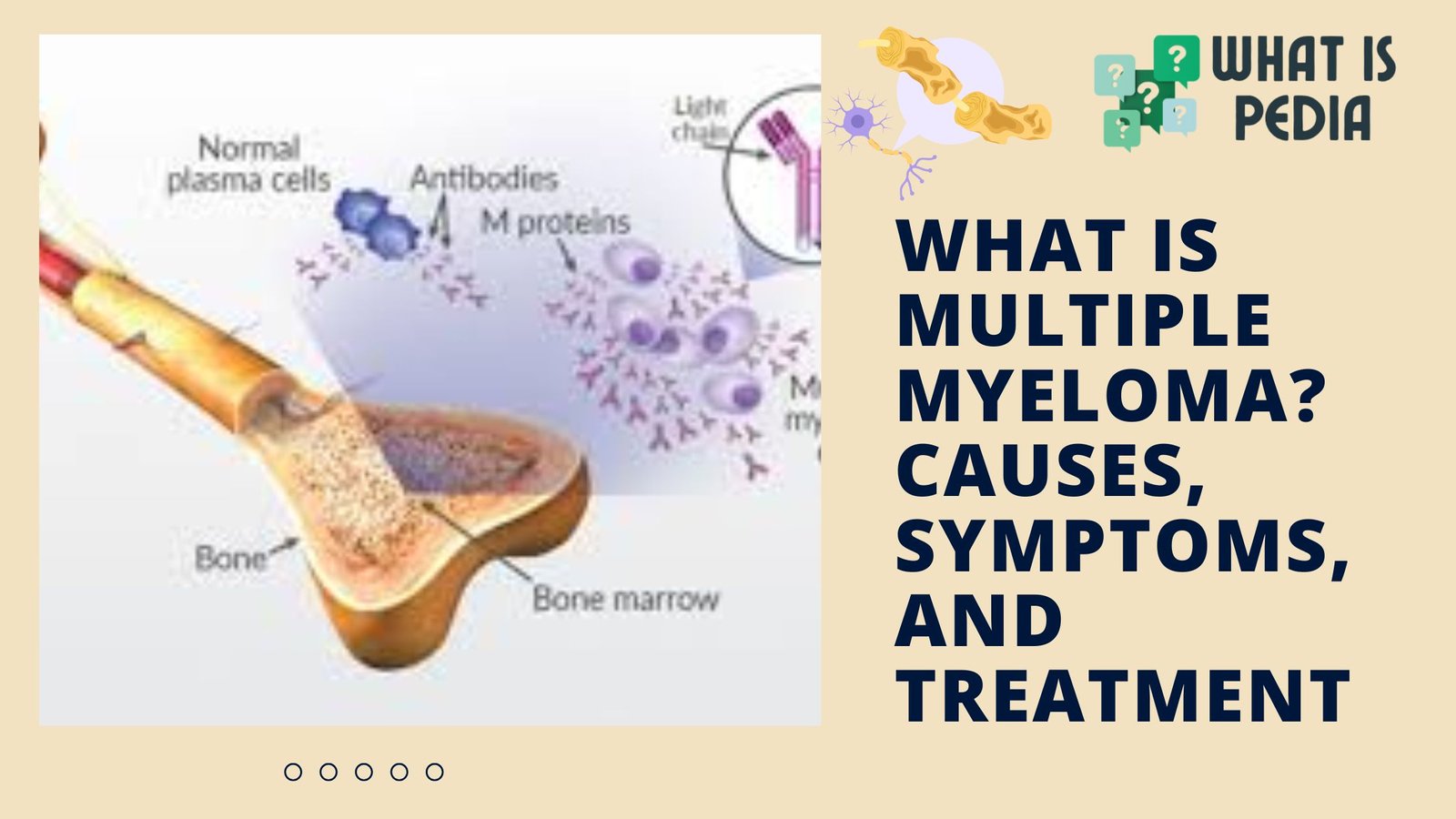Introduction
Multiple myeloma is a bone marrow cancer that originates in plasma cells, a crucial part of the immune system responsible for producing antibodies to fight infections. In multiple myeloma, abnormal plasma cells grow uncontrollably in the bone marrow, leading to excessive production of faulty antibodies known as M proteins. This abnormal proliferation affects the production of normal blood cells, causing complications like anemia, weakened immunity, kidney damage, and bone loss.
As a type of bone marrow cancer, multiple myeloma falls under the category of hematologic malignancies. It differs from other cancers because it directly impacts the bone marrow’s ability to generate healthy blood cells. The presence of multiple myeloma plasma cells disrupts the body’s defense system and weakens bones, making them prone to fractures.
Early diagnosis is essential in improving multiple myeloma prognosis. Identifying multiple myeloma symptoms such as persistent bone pain, fatigue, and frequent infections can lead to early medical intervention. Through advanced treatments like chemotherapy, immunotherapy, and stem cell transplants, multiple myeloma patients can manage the disease effectively. Raising awareness about multiple myeloma causes and its impact can aid in prompt diagnosis and better treatment outcomes.
1. Understanding Multiple Myeloma
Definition of Multiple Myeloma
Multiple myeloma is a malignant disorder where plasma cells in the bone marrow multiply uncontrollably. Normally, plasma cells produce antibodies to protect the body from infections. However, in multiple myeloma, these cells become cancerous and overproduce abnormal proteins, which interfere with normal bodily functions.
Difference Between Myeloma and Other Bone Marrow Cancers
Unlike leukemia and lymphoma, which also affect blood cells, myeloma specifically targets plasma cells. Leukemia affects white blood cells in the bloodstream, while lymphoma impacts the lymphatic system. Multiple myeloma is unique because it primarily leads to the deterioration of bone marrow and bones.
How Multiple Myeloma Plasma Cells Affect the Immune System
Cancerous plasma cells produce ineffective antibodies that do not protect against infections. This weakens the immune system, making multiple myeloma patients more vulnerable to bacterial and viral infections. Additionally, the excessive accumulation of abnormal plasma cells leads to reduced production of red blood cells, resulting in anemia and fatigue.
Importance of Bone Marrow in Blood Cell Production
Bone marrow is a soft, spongy tissue inside bones that produces blood cells. It contains hematopoietic stem cells that develop into red blood cells, white blood cells, and platelets. When multiple myeloma plasma cells overpopulate the bone marrow, they interfere with this natural process, leading to severe health complications such as bone fractures, blood disorders, and immune deficiencies.
2. Multiple Myeloma Etiology
What is the Root Cause of Multiple Myeloma Etiology?
The exact cause of multiple myeloma etiology is unknown. However, researchers believe that genetic mutations and environmental factors contribute to the abnormal growth of plasma cells.
Risk Factors Contributing to the Disease
Several risk factors increase the likelihood of developing multiple myeloma:
- Age: Most cases occur in individuals over 60.
- Gender: Men are slightly more prone than women.
- Ethnicity: African Americans have a higher risk.
- Family history: A history of myeloma in the family increases susceptibility.
Connection Between Bone Marrow Cancer and Plasma Cell Abnormalities
Plasma cells originate in the bone marrow, where they should function normally. In multiple myeloma, genetic alterations cause plasma cells to multiply uncontrollably, leading to bone marrow cancer. The presence of these abnormal cells results in an imbalance in normal blood cell production.
3. Multiple Myeloma Causes
Genetic Mutations in Multiple Myeloma
Mutations in specific genes such as TP53, MYC, and KRAS contribute to the development of multiple myeloma. These mutations allow cancerous plasma cells to evade the body’s defense mechanisms and multiply uncontrollably.
Environmental and Lifestyle Factors
- Exposure to harmful chemicals like benzene and pesticides.
- Radiation exposure linked to higher risks of developing multiple myeloma.
- Obesity and poor diet contributing to inflammation and cellular mutations.
Does Exposure to Chemicals or Radiation Increase Risk?
Yes, prolonged exposure to chemicals and ionizing radiation can damage DNA, leading to genetic mutations that cause multiple myeloma.
4. Is Multiple Myeloma Hereditary?
Exploring the Genetic Aspect: Is Multiple Myeloma Hereditary?
While multiple myeloma is not strictly hereditary, having a family history of the disease slightly increases the risk.
Family History and Risk Factors
Studies suggest that first-degree relatives of multiple myeloma patients are more susceptible to developing the disease.
Genetic Predisposition vs. Environmental Triggers
Genetic factors may increase susceptibility, but environmental exposures play a larger role in triggering multiple myeloma.
5. Multiple Myeloma Symptoms: Early and Advanced Signs
What is the First Sign of Multiple Myeloma?
Early symptoms often include bone pain, particularly in the back and ribs.
Common Symptoms:
- Bone pain from weakened bones
- Fatigue due to anemia
- Frequent infections from weakened immunity
- Kidney problems due to protein buildup
Difference Between Early and Late-Stage Symptoms
In early stages, symptoms are mild, but advanced multiple myeloma causes severe organ damage and fractures.
6. How Serious is Myeloma Cancer?
How Serious is Myeloma Cancer?
Multiple myeloma is a life-threatening disease that requires immediate medical attention.
Impact on Overall Health and Organ Function
Cancerous plasma cells affect kidney function, immunity, and bone structure.
Complications and Progression Without Treatment
Untreated multiple myeloma leads to severe bone loss, infections, and multi-organ failure.
7. Multiple Myeloma Diagnosis
Diagnostic Tests:
- Blood tests to detect M proteins
- Bone marrow biopsy to confirm abnormal plasma cells
- Imaging scans to detect bone damage
Importance of Early Detection for Better Prognosis
Timely diagnosis improves multiple myeloma prognosis and treatment success.
8. Multiple Myeloma Treatment Options
Chemotherapy
Targets cancerous plasma cells to slow disease progression.
Immunotherapy
Boosts the immune system’s power to target and destroy cancer cells.
Stem Cell Transplant
Replaces damaged bone marrow with healthy stem cells.
Emerging Treatment Options
New drugs like CAR-T therapy show promising results.
9. Multiple Myeloma Prognosis and Life Expectancy
Factors Affecting Multiple Myeloma Prognosis
Age, stage of diagnosis, and treatment response impact survival rates.
Survival Rates and Treatment Advancements
New treatments have improved survival rates significantly.
Quality of Life with Treatment
Early intervention allows multiple myeloma patients to live longer with better health.
Conclusion
Understanding what is multiple myeloma is vital for early diagnosis and effective treatment. By recognizing multiple myeloma symptoms early, patients can seek timely medical intervention. Advances in chemotherapy, immunotherapy, and bone marrow transplants have significantly improved multiple myeloma prognosis. If you or a loved one is experiencing symptoms, consult a doctor immediately.
Read More: What is Leukemia Disease? Causes, Symptoms, Types & Treatment







